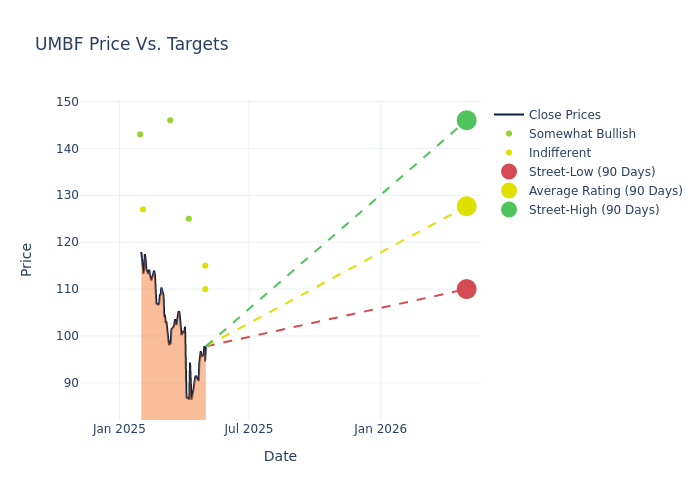Deep Dive Into UMB Financial Stock: Analyst Perspectives (6 Ratings)
Throughout the last three months, 6 analysts have evaluated UMB Financial (NASDAQ:UMBF), offering a diverse set of opinions from bullish to bearish.
The following table summarizes their recent ratings, shedding light on the changing sentiments within the past 30 days and comparing them to the preceding months.
| Bullish | Somewhat Bullish | Indifferent | Somewhat Bearish | Bearish | |
|---|---|---|---|---|---|
| Total Ratings | 0 | 2 | 4 | 0 | 0 |
| Last 30D | 0 | 0 | 2 | 0 | 0 |
| 1M Ago | 0 | 1 | 1 | 0 | 0 |
| 2M Ago | 0 | 1 | 0 | 0 | 0 |
| 3M Ago | 0 | 0 | 1 | 0 | 0 |
The 12-month price targets, analyzed by analysts, offer insights with an average target of $121.33, a high estimate of $146.00, and a low estimate of $105.00. A negative shift in sentiment is evident as analysts have decreased the average price target by 6.43%.

Understanding Analyst Ratings: A Comprehensive Breakdown
The analysis of recent analyst actions sheds light on the perception of UMB Financial by financial experts. The following summary presents key analysts, their recent evaluations, and adjustments to ratings and price targets.
| Analyst | Analyst Firm | Action Taken | Rating | Current Price Target | Prior Price Target |
|---|---|---|---|---|---|
| Karl Shepard | RBC Capital | Lowers | Sector Perform | $115.00 | $128.00 |
| Timur Braziler | Wells Fargo | Raises | Equal-Weight | $110.00 | $105.00 |
| Timur Braziler | Wells Fargo | Lowers | Equal-Weight | $105.00 | $120.00 |
| Jared Shaw | Barclays | Lowers | Overweight | $125.00 | $139.00 |
| Brian Wilczynski | Morgan Stanley | Lowers | Overweight | $146.00 | $156.00 |
| Benjamin Gerlinger | Citigroup | Lowers | Neutral | $127.00 | $130.00 |
Key Insights:
- Action Taken: In response to dynamic market conditions and company performance, analysts update their recommendations. Whether they 'Maintain', 'Raise', or 'Lower' their stance, it signifies their reaction to recent developments related to UMB Financial. This insight gives a snapshot of analysts' perspectives on the current state of the company.
- Rating: Providing a comprehensive analysis, analysts offer qualitative assessments, ranging from 'Outperform' to 'Underperform'. These ratings reflect expectations for the relative performance of UMB Financial compared to the broader market.
- Price Targets: Understanding forecasts, analysts offer estimates for UMB Financial's future value. Examining the current and prior targets provides insight into analysts' changing expectations.
Considering these analyst evaluations in conjunction with other financial indicators can offer a comprehensive understanding of UMB Financial's market position. Stay informed and make well-informed decisions with our Ratings Table.
Stay up to date on UMB Financial analyst ratings.
About UMB Financial
UMB Financial Corp, or UMBF, is a financial services holding company offering a suite of banking services and asset servicing to its customers in the United States and around the world. Its client base includes commercial, institutional, and personal customers. Along with its subsidiaries, the company operates in the following business segments: Commercial Banking, Institutional Banking, and Personal Banking. A majority of its revenue is generated from the Commercial Banking segment, which serves the commercial banking and treasury management needs of small to middle-market businesses through various products and services such as commercial loans, commercial real estate financing, commercial credit cards, letters of credit, loan syndication services, consultative services, and others.
UMB Financial: Financial Performance Dissected
Market Capitalization Perspectives: The company's market capitalization falls below industry averages, signaling a relatively smaller size compared to peers. This positioning may be influenced by factors such as perceived growth potential or operational scale.
Revenue Growth: UMB Financial's revenue growth over a period of 3M has been noteworthy. As of 31 March, 2025, the company achieved a revenue growth rate of approximately 29.42%. This indicates a substantial increase in the company's top-line earnings. When compared to others in the Financials sector, the company faces challenges, achieving a growth rate lower than the average among peers.
Net Margin: UMB Financial's net margin is below industry standards, pointing towards difficulties in achieving strong profitability. With a net margin of 15.94%, the company may encounter challenges in effective cost control.
Return on Equity (ROE): UMB Financial's ROE is below industry standards, pointing towards difficulties in efficiently utilizing equity capital. With an ROE of 1.61%, the company may encounter challenges in delivering satisfactory returns for shareholders.
Return on Assets (ROA): UMB Financial's ROA is below industry standards, pointing towards difficulties in efficiently utilizing assets. With an ROA of 0.14%, the company may encounter challenges in delivering satisfactory returns from its assets.
Debt Management: The company maintains a balanced debt approach with a debt-to-equity ratio below industry norms, standing at 0.1.
The Basics of Analyst Ratings
Experts in banking and financial systems, analysts specialize in reporting for specific stocks or defined sectors. Their comprehensive research involves attending company conference calls and meetings, analyzing financial statements, and engaging with insiders to generate what are known as analyst ratings for stocks. Typically, analysts assess and rate each stock once per quarter.
Beyond their standard evaluations, some analysts contribute predictions for metrics like growth estimates, earnings, and revenue, furnishing investors with additional guidance. Users of analyst ratings should be mindful that this specialized advice is shaped by human perspectives and may be subject to variability.
Which Stocks Are Analysts Recommending Now?
Benzinga Edge gives you instant access to all major analyst upgrades, downgrades, and price targets. Sort by accuracy, upside potential, and more. Click here to stay ahead of the market.
This article was generated by Benzinga's automated content engine and reviewed by an editor.